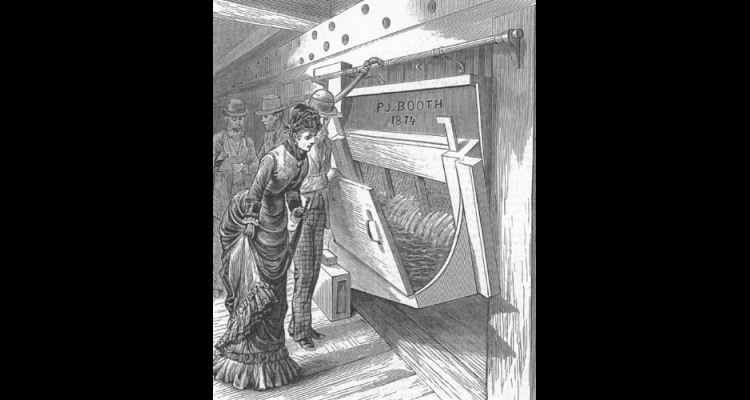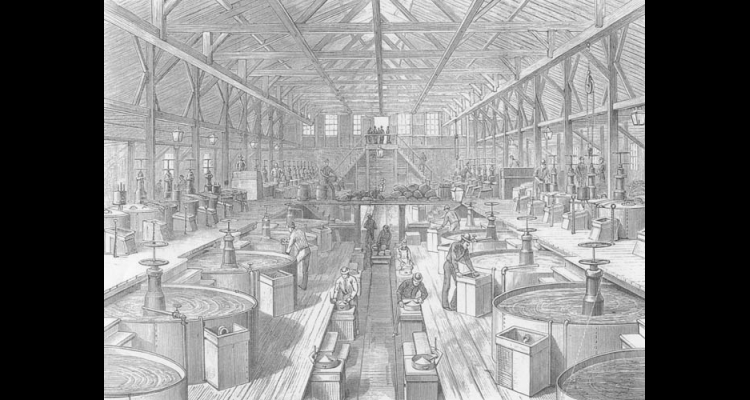Milling Technology in the Nineteenth Century
One of the greatest challenges the mining industry faces is the extraction of resources from ore, the material that encases valuable minerals. This task follows the better known first phase of mining, the retrieval of ore from the surface or underground. During the nineteenth century, Nevada industrialists revolutionized the milling of gold and silver ore.
Nineteenth-century millers used various techniques. Most employed mercury, a metal that readily bonds with gold and silver to form what is known as an amalgam. This compound—once a standard for dental work—could be heated to boil off the mercury, leaving the precious metal behind. Placer miners, who arrived in the West with the 1849 California Gold Rush, often used this approach after washing loose soil containing diffused microscopic gold.
Underground mining demanded a different approach because it retrieved rock rather than loose soil. Milling of underground ore went through several phases including crushing, heating and mixing with water and chemicals, extraction, and retorting. Initially, miners employed the traditional arrastra mill. This Spanish-based mechanism consisted of a circular patio of flat stones. A horse tethered to a central post would haul heavy stones, crushing the ore. Then, the arrastra served as a large tub where water and chemicals could be added, taking advantage of the sun's warmth to escalate the chemical process of extraction. This was particularly useful for silver ore, often in the form of silver chloride, which required both salt and heat to alter the material before adding mercury for amalgamation and extraction.
Early Comstock miners constructed arrastras in 1859, but these proved generally inadequate for the extensive Comstock ore bodies. The mills were unable to handle the quantity of ore, and the northern latitude reduced the effectiveness of solar heat.
In 1860, Almarin Paul erected the first of a new type of mill in what would become Nevada. He employed a technology more in keeping with the emergence of modern mining. The first phase of this new approach was the stamp mill, a structure holding heavy pistons that rose and fell, breaking down ore. The mill operator then combined pulverized ore with water and chemicals including mercury in a "pan."
During the 1860s, Comstock mills became huge industrial plants processing tons of ore. Dependent on water, mills were situated below Virginia City in Six Mile Canyon, in Dayton along the Carson River, and at the edge of Washoe Lake. The 1869 opening of the Virginia and Truckee Railroad encouraged mill operators to relocate along the Carson River in Brunswick Canyon, east of Carson City. The shift took business away from the other mills, virtually starving Washoe Valley towns out of existence and causing a decline in Dayton's fortunes.
Comstock mills set the industrial standard internationally, but ores in other locations demanded variations. The silver ore of Eureka, Nevada, for example, included lead. While the intrusive metal had its own value, it provided a challenge, which invention eventually addressed.
In spite of the effort and expense, nineteenth-century mills could be terribly inefficient. Much silver, in particular, was lost because, unlike gold, it bonded easily with other chemicals. The introduction of a cyanide process, developed between 1887 and 1897, proved more efficient with gold ore. It exploited the fact that gold dissolves in a solution of sodium-cyanide. Millers washed pulverized ore with the solution, poured off the result, and mixed it with zinc shavings, which left the gold behind.
In 1896, Professor Robert Jackson from the University of Nevada School of Mines, used the cyanide process on mill tailings in Washoe Valley. The efficient, cost effective approach made marginal ore bodies profitable, inspiring a frenzy of turn-of-the-century exploration and a subsequent mining boom. Mercury-based mills quickly became a thing of the past, and the industry stepped into a new century.
Article Locations
Related Articles
None at this time.




